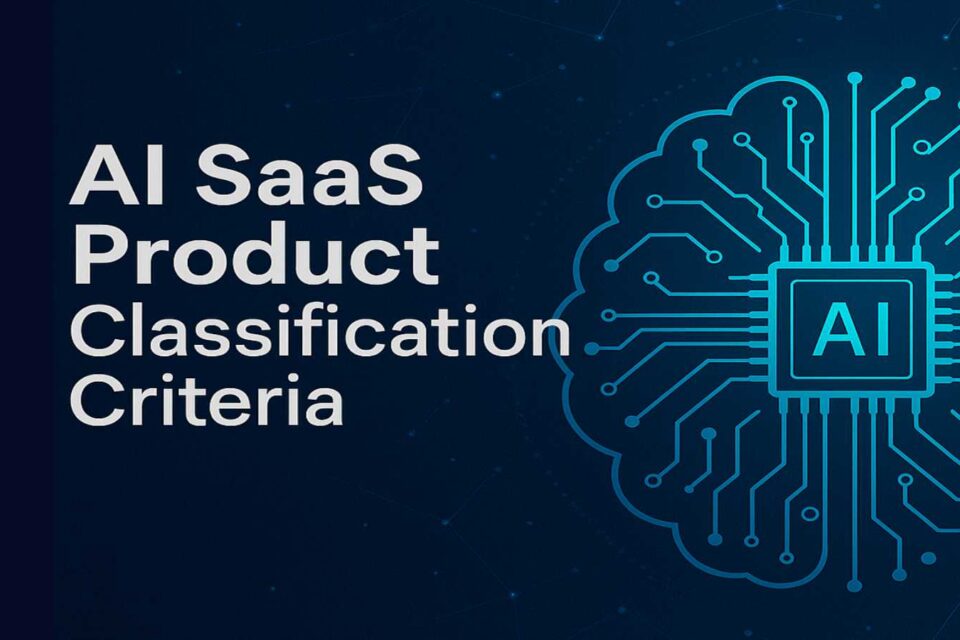AI SaaS Product Classification Criteria: A Complete Framework for Modern Software Developmen

As artificial intelligence continues to evolve, the Software-as-a-Service (SaaS) landscape is undergoing rapid transformation. Businesses are increasingly turning to AI-enhanced SaaS solutions to automate workflows, improve decision-making, and drive operational efficiency. However, with this growing complexity comes the need for a clear framework to evaluate these tools. That’s where AI SaaS Product Classification Criteria become essential.
In this article, we’ll break down the most important criteria for classifying AI SaaS products. Whether you’re a startup founder, enterprise buyer, or product developer, understanding these criteria will help you identify, build, and scale intelligent software more effectively.
What Are AI SaaS Product Classification Criteria?
AI SaaS Product Classification Criteria refer to a structured set of dimensions used to categorize AI-powered software tools delivered through cloud-based SaaS platforms. These criteria allow stakeholders to assess how AI is integrated, what functions the software performs, how it’s deployed, and who it serves.
Proper classification ensures that businesses can choose the right tool based on their needs, technical capabilities, and industry requirements.
Why Classification Criteria Matter
The AI SaaS ecosystem is expanding rapidly across industries. From healthcare diagnostics to marketing automation and supply chain analytics, AI is redefining software capabilities. Without proper AI SaaS Product Classification Criteria, it becomes difficult to:
- Evaluate tools on an apples-to-apples basis.
- Understand scalability and integration options.
- Ensure regulatory compliance and ethical AI usage.
- Align tools with specific business goals.
Clear classification promotes transparency, discoverability, and decision-making.
1. Function-Based Classification
Classifying AI SaaS by business function is one of the most intuitive approaches:
- Sales and Marketing AI SaaS: Email optimization, lead scoring, SEO analysis.
- Customer Service AI SaaS: Chatbots, ticket automation, sentiment tracking.
- Finance and Accounting: Fraud detection, forecasting, automated reconciliation.
- HR and Talent Management: Resume parsing, employee sentiment analysis.
This function-based AI SaaS Product Classification Criteria makes it easier for buyers to evaluate relevance quickly.
2. Classification by AI Technology Used
Another essential layer in AI SaaS Product Classification Criteria is the underlying technology:
- Machine Learning: Dynamic algorithms that adapt over time.
- NLP (Natural Language Processing): Language-based AI for chatbots, transcription.
- Computer Vision: AI tools that analyze images or video data.
- Generative AI: Content creation, code generation, and visual generation tools.
The specific technology impacts performance, speed, and application scope.
3. Deployment Model Classification
Deployment structure is crucial in AI SaaS Product Classification Criteria, especially for enterprise environments:
- Multi-Tenant Cloud SaaS: Shared infrastructure, scalable, low-cost.
- Private Cloud or Hybrid SaaS: Enhanced security for regulated industries.
- Edge AI SaaS: Processing data locally for real-time responsiveness.
Deployment choices influence compliance, latency, and architecture decisions.
4. Classification by Data Handling Approach
Data is the fuel for AI. Classification criteria for AI SaaS products must take towards considered:
- Data Source: Internal (CRM, ERP), external (web, sensors), or real-time.
- Data Type: Structured (tables, databases) vs. unstructured (text, images).
- Data Flow: Stream-based vs. batch processing.
Tools that handle sensitive data should also support encryption, GDPR compliance, and anonymization.
5. Target Market and Role-Based Classification
This layer in AI SaaS Product Classification Criteria focuses on who uses the tool:
- SMBs vs. Enterprise SaaS: Size and complexity of AI models.
- Industry-Specific Tools: Healthcare AI, FinTech AI, Retail AI.
- Role-Based AI SaaS: Platforms tailored for developers, marketers, analysts, or HR teams.
Proper targeting enhances usability and ROI.
6. Integration and API Flexibility
Modern SaaS platforms must integrate easily. As part of AI SaaS Product Classification Criteria, tools can be grouped by:
- Native Integrations: Direct plugins to Slack, Salesforce, or Google Workspace.
- API-Driven: Developer-friendly platforms for custom extensions.
- Ecosystem Membership: Participation in larger SaaS marketplaces (like AWS Marketplace).
The more flexible the integration, the greater the enterprise adoption potential.
7. Automation and Intelligence Level
Not all AI is created equal. Consider this dimension in your AI SaaS Product Classification Criteria:
- Rule-Based AI: Limited flexibility, uses pre-defined logic.
- Predictive AI: Uses data trends to forecast outcomes.
- Autonomous AI: Self-learning models that improve without human intervention.
This affects performance expectations, model retraining, and maintenance effort.
8. Compliance and Ethical Standards
With the rise of AI regulation, ethical classification is crucial:
- Bias Detection: Algorithms that assess fairness and accuracy.
- Auditability: Logs, model decisions, and traceability.
- Regulatory Compliance: GDPR, HIPAA, ISO 27001 standards.
Responsible AI SaaS Product Classification Criteria must always consider these safeguards.
9. User Interface and Experience
UI/UX plays a major role in tool adoption. AI SaaS tools can be:
- No-Code Platforms: For business users and marketers.
- Low-Code/Pro-Code Platforms: For developers and data scientists.
- Conversational Interfaces: Chat-based, voice-based, or visual search AI.
UI also impacts onboarding, training time, and user satisfaction.
10. Monetization Model
Pricing is a critical point in AI SaaS Product Classification Criteria:
- Freemium with Add-ons
- Flat-Rate Subscription
- Usage-Based Billing
- Enterprise Licensing
Understanding pricing helps businesses align features with budget.
Conclusion
As AI continues to power next-generation software platforms, having a robust framework for categorizing and understanding these products becomes essential. The AI SaaS Product Classification Criteria discussed in this guide help demystify the landscape by providing structure, clarity, and strategic insight. Whether you’re evaluating a new vendor, building your own AI tool, or investing in the space, these criteria offer a practical roadmap to smarter software decisions in 2025 and beyond.
